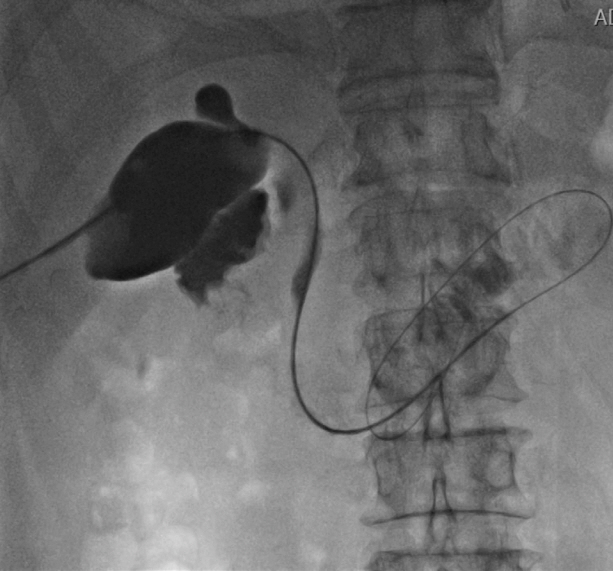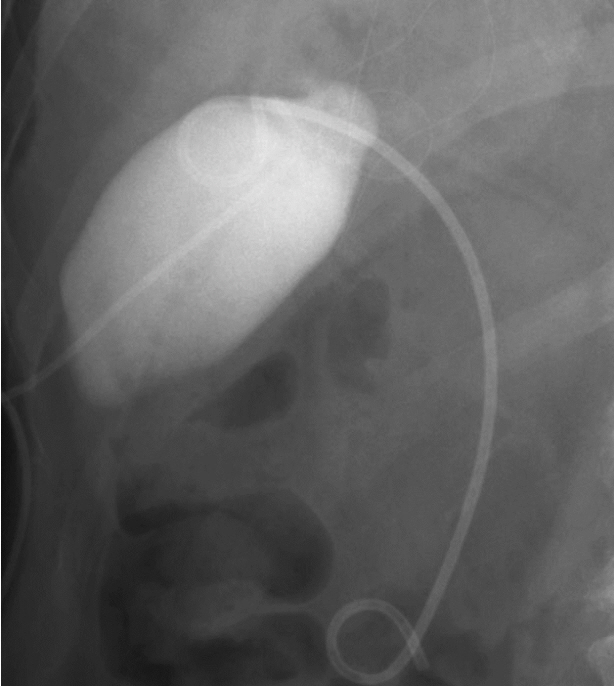Clin Endosc.
2017 May;50(3):301-304. 10.5946/ce.2016.120.
Conversion of Percutaneous Cholecystostomy to Endoscopic Gallbladder Stenting by Using the Rendezvous Technique
- Affiliations
-
- 1Division of Gastroenterology, Department of Internal Medicine, Dankook University Hospital, Dankook University College of Medicine, Cheonan, Korea. mdcjh78@gmail.com
- KMID: 2388829
- DOI: http://doi.org/10.5946/ce.2016.120
Abstract
- We report the successful conversion of percutaneous cholecystostomy (PC) to endoscopic transpapillary gallbladder stenting (ETGS) with insertion of an antegrade guidewire into the duodenum. An 84-year-old man presented with severe acute cholecystitis and septic shock. He had significant comorbidities, and emergent PC was successfully performed. Subsequent ETGS was attempted but unsuccessful owing to difficulties with cystic duct cannulation. However, via the PC tract, the guidewire was passed antegradely into the duodenum, and ETGS with a double-pigtail plastic stent was successfully performed with the rendezvous technique. The PC tube was removed, and no recurrence was reported during the 17-month follow-up period. Conversion of PC to ETGS is a viable option in patients with acute cholecystitis who are not candidates for surgery. Antegrade guidewire insertion via the PC tract may increase the success rate of conversion and decrease the risk of procedure-related complications.
Keyword
MeSH Terms
Figure
Reference
-
1. Spira RM, Nissan A, Zamir O, Cohen T, Fields SI, Freund HR. Percutaneous transhepatic cholecystostomy and delayed laparoscopic cholecystectomy in critically ill patients with acute calculus cholecystitis. Am J Surg. 2002; 183:62–66.
Article2. McKay A, Abulfaraj M, Lipschitz J. Short- and long-term outcomes following percutaneous cholecystostomy for acute cholecystitis in highrisk patients. Surg Endosc. 2012; 26:1343–1351.
Article3. Akhan O, Akinci D, Ozmen MN. Percutaneous cholecystostomy. Eur J Radiol. 2002; 43:229–236.
Article4. Itoi T, Coelho-Prabhu N, Baron TH. Endoscopic gallbladder drainage for management of acute cholecystitis. Gastrointest Endosc. 2010; 71:1038–1045.
Article5. Jang JW, Lee SS, Song TJ, et al. Endoscopic ultrasound-guided transmural and percutaneous transhepatic gallbladder drainage are comparable for acute cholecystitis. Gastroenterology. 2012; 142:805–811.
Article6. Lee TH, Park DH, Lee SS, et al. Outcomes of endoscopic transpapillary gallbladder stenting for symptomatic gallbladder diseases: a multicenter prospective follow-up study. Endoscopy. 2011; 43:702–708.
Article7. Maekawa S, Nomura R, Murase T, Ann Y, Oeholm M, Harada M. Endoscopic gallbladder stenting for acute cholecystitis: a retrospective study of 46 elderly patients aged 65 years or older. BMC Gastroenterol. 2013; 13:65.
Article8. Hatanaka T, Itoi T, Ijima M, et al. Efficacy and Safety of Endoscopic Gallbladder Stenting for Acute Cholecystitis in Patients with Concomitant Unresectable Cancer. Intern Med. 2016; 55:1411–1417.
Article9. Matsubayashi H, Maeda A, Fukutomi A, Ono H. A case of choledocholithiasis treated by parallel cannulation along with PTGBD rendezvous. Clin J Gastroenterol. 2009; 2:36–38.
Article10. Banerjee B, Harshfield DL, Teplick SK. Percutaneous transcholecystic approach to the rendezvous procedure when transhepatic access fails. J Vasc Interv Radiol. 1994; 5:895–898.
Article11. Okuno M, Iwashita T, Yasuda I, et al. Percutaneous transgallbladder rendezvous for enteroscopic management of choledocholithiasis in patients with surgically altered anatomy. Scand J Gastroenterol. 2013; 48:974–978.
Article12. Law R, Grimm IS, Stavas JM, Baron TH. Conversion of Percutaneous Cholecystostomy to Internal Transmural Gallbladder Drainage Using an Endoscopic Ultrasound-Guided, Lumen-Apposing Metal Stent. Clin Gastroenterol Hepatol. 2016; 14:476–480.
Article13. Schlenker C, Trotter JF, Shah RJ, et al. Endoscopic gallbladder stent placement for treatment of symptomatic cholelithiasis in patients with end-stage liver disease. Am J Gastroenterol. 2006; 101:278–283.
Article14. Mutignani M, Iacopini F, Perri V, et al. Endoscopic gallbladder drainage for acute cholecystitis: technical and clinical results. Endoscopy. 2009; 41:539–546.
Article15. Elmunzer BJ, Novelli PM, Taylor JR, Piraka CR, Shields JJ. Percutaneous cholecystostomy as a bridge to definitive endoscopic gallbladder stent placement. Clin Gastroenterol Hepatol. 2011; 9:18–20.
Article16. Lee TH, Park SH, Lee SH, et al. Modified rendezvous intrahepatic bile duct cannulation technique to pass a PTBD catheter in ERCP. World J Gastroenterol. 2010; 16:5388–5390.
Article
- Full Text Links
- Actions
-
Cited
- CITED
-
- Close
- Share
- Similar articles
-
- Endoscopic Gallbladder Drainage Conversion versus Conservative Treatment Following Percutaneous Gallbladder Drainage in High-Risk Surgical Patients
- Percutaneous Transhepatic Gallbladder Stenting for Acute Cholecystitis after Palliative Metallic Biliary Stenting
- Current Status of Endoscopic Gallbladder Drainage
- A successful rendezvous endoscopic ultrasonography-guided gallbladder drainage in malignant cystic duct obstruction
- Percutaneous cholecystostomy





